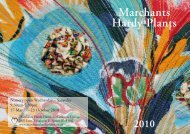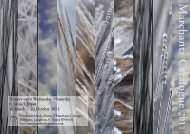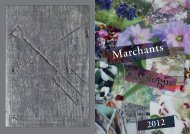download our catalogue free in pdf format here - Marchants Hardy ...
download our catalogue free in pdf format here - Marchants Hardy ...
download our catalogue free in pdf format here - Marchants Hardy ...
Create successful ePaper yourself
Turn your PDF publications into a flip-book with our unique Google optimized e-Paper software.
12<br />
13<br />
ERODIUM. The <strong>free</strong> flower<strong>in</strong>g Storksbills are related to Pelargonium and to true<br />
Geraniums, the Cranesbills. They adore sun and limestone and revel on chalk and other<br />
<strong>free</strong> dra<strong>in</strong><strong>in</strong>g soils. On wet soils their thick necks are prone to rot <strong>in</strong> which case raised<br />
beds or walls offer a suitable compromise. We love them and grow quite a number.<br />
Hopefully we’ll have some of the follow<strong>in</strong>g available by June.<br />
E. ‘Grey Blush’, E x kolbianum. E. ‘Nunwood P<strong>in</strong>k’, E. ‘Spanish Eyes’, etc.<br />
ERYNGIUM. The Eryngos, with their well designed defense mechanisms, are a<br />
prickly bunch of characters but make with both their flowers and their foliage strik<strong>in</strong>g<br />
garden plants. What’s more, they’re not difficult to please, given sun and reasonable<br />
dra<strong>in</strong>age. In cultivation they are divided between species from Europe and South<br />
America, plus the odd hybrid. If you don’t grow them, why not give them a try.<br />
E. b<strong>our</strong>gatii. Seedl<strong>in</strong>gs from a form with particularly deep metallic blue flower heads<br />
and bracts. In the wild it grows <strong>in</strong> poor, stony soil. 60cm.<br />
*E. giganteum ‘Silver Ghost’. The bleached pallor of the vengeful sp<strong>in</strong>y bracts of this<br />
strik<strong>in</strong>g biennial present themselves at thigh/bottom level so should be positioned<br />
with care!<br />
E. x oliveranum. An old E. alp<strong>in</strong>um hyrbrid, now hard to f<strong>in</strong>d, both stems and sp<strong>in</strong>y<br />
bracted flowers be<strong>in</strong>g cobalt blue. 60cm.<br />
*E. pandanifolium. Of great architectural presence, <strong>in</strong> September great flower<strong>in</strong>g<br />
trunks rise to 2.5 metres over sword shaped leaves term<strong>in</strong>at<strong>in</strong>g <strong>in</strong> a branched<br />
network of small maroon-purple flowers whose scent, once encountered, is not<br />
easily forgotten.<br />
*E. planum. Rather an unfortunate name for such a good garden plant. Always<br />
provides a reliable and dazzl<strong>in</strong>g display of its small silvery blue flowers. 1m+<br />
*E. serbicum. To <strong>our</strong> eyes, like a small form of E.planum with silvery blue flowers and<br />
narrow bracts. Uncommon. 60cm.<br />
*E x Zabellii. These are basically E. alp<strong>in</strong>um hybrids. Most are exceptional with steely<br />
blue ruff-like bracts but they are not always easy to grow preferr<strong>in</strong>g we th<strong>in</strong>k good<br />
dra<strong>in</strong>age but not dryness. We grow several forms and hope to have some of these<br />
available by mid-summer.<br />
EUCOMIS. The follow<strong>in</strong>g are among the most commented on plants <strong>in</strong> the garden<br />
at <strong>Marchants</strong>. Their exotic look belies their dogged hard<strong>in</strong>ess. We have yet to lose a<br />
plant to cold but have noticed a complete dislike of be<strong>in</strong>g shouldered out by expansive<br />
neighb<strong>our</strong>s. Worth cosset<strong>in</strong>g, <strong>our</strong> plants get a thick mulch of compost to see them safely<br />
through the w<strong>in</strong>ter.<br />
E. ex Harry Hay. These plants were raised by leaf blade cutt<strong>in</strong>gs begged from the<br />
good man himself. The orig<strong>in</strong>al plant was noted for its highly ornamental bottle<br />
green seed capsules, not a feature that one would usually clock with this genus. F<strong>our</strong><br />
years on and height and flower col<strong>our</strong> rema<strong>in</strong> unknown.<br />
E. ex ‘John Treasure’. This form has a particularly good purple hue to the leaves,<br />
stems and flowers. Grow this well and you’ll have someth<strong>in</strong>g to boast about. 45cm.<br />
E. ‘<strong>Marchants</strong> Purple Wave’. A seedl<strong>in</strong>g I selected several years ago for the curious<br />
waved marg<strong>in</strong>s of the dark purple leaves, dusky p<strong>in</strong>k flowers and short height. 35cm.<br />
E. pallidiflora. A fantastic creation. Succulent strap-like basal leaves, stem and palest<br />
green flowers all topped with a P<strong>in</strong>eapple like fl<strong>our</strong>ish. <strong>Hardy</strong> <strong>in</strong> the ground but less<br />
so <strong>in</strong> pots. 90cm.<br />
E. ‘Sparkl<strong>in</strong>g Burgundy’. The terrific strap like succulent leaves are deep matt purple,<br />
a tone shared by the flower<strong>in</strong>g stems and flowers, albeit a little diluted. A remarkable<br />
plant. 1m. <strong>in</strong> flower.<br />
From<br />
£5.00<br />
From<br />
£4.60<br />
From<br />
£5.00<br />
EUCOMIS ‘Sparkl<strong>in</strong>g Burgundy Seedl<strong>in</strong>gs’. Flower<strong>in</strong>g sized plants are offered. Why<br />
not throw the dice and try one of the children.<br />
E. zambesiaca. At 30cm a small scale E. pallidiflora but equally characterful. <strong>Hardy</strong><br />
and just the plant for a classy stoneware pot. A few to spare.<br />
EUPATORIUM ligustr<strong>in</strong>um. Not a shrub that flamboyantly announces itself, but<br />
highly effective none-the-less. Its good evergreen foliage, structure and fluffy white<br />
flower heads <strong>in</strong> late summer beautifully partners Asters and late flower<strong>in</strong>g grasses. 2m.<br />
*E. purpureum maculatum album. We hope to have plants available of this<br />
uncommon white form for sale. 2m+.<br />
*E. p. m. ‘Ankum’s August’. The claim from Nurseryman friend Coen Jansen that his<br />
plant will grow to only 140cm has been severely put to the test on <strong>our</strong> rich clay. A<br />
little taller <strong>here</strong>, it rema<strong>in</strong>s a good plant.<br />
*E. p. m. ‘Orchard Dene’. Stood out <strong>in</strong> the Wisley trials with its huge heads showy<br />
flowers and dark stems and deservedly awarded an. AGM.<br />
E. p. m. ex. ‘Orchard Dene’. Flower<strong>in</strong>g sized plants raised from seed of the above.<br />
*E. p. m. ‘Purple Bush’. Fills a niche <strong>in</strong> be<strong>in</strong>g shorter than the type form yet identical<br />
<strong>in</strong> every other respect. 1.5m.<br />
E. p. m. ‘Riesenschirm’. Stout, glossy purple stems rise to 2.2m, climax<strong>in</strong>g <strong>in</strong> a display<br />
of dusky rose-purple domed flower heads. A dist<strong>in</strong>guished late summer perennial.<br />
E. rugosum ‘Chocolate’. Snakeroot. Strik<strong>in</strong>g black-purple foliage and domed heads of<br />
white flowers <strong>in</strong> autumn. An asset on all accounts for any fertile border <strong>in</strong> full sun.<br />
1.5m.<br />
EUPHORBIA. Given reasonable dra<strong>in</strong>age the Spurges are easy to please and give<br />
us all that we should expect of a plant. Do however be cautious of the white sap they<br />
exude when torn or damaged. It can burn sk<strong>in</strong> badly.<br />
E. donii ‘Amjillasa’. A very handsome Kew collection from Nepal with large, chrome<br />
yellow flower bracts. Seed raised. plants are offered. 1m+.<br />
E. griffithii ‘Fern Cottage’. A very good form with decorative fiery reddish-orange<br />
flower bracts to enliven the late spr<strong>in</strong>g border. 90cm.<br />
E. jacquemontii. We hope to have a few plants to spare of this Himalayan rarity.<br />
E. ‘Jade Dragon’. An E. amygdaloides hybrid, the heads of showy green flowers<br />
punctuated with a conspicuous red eye fade to an equally beautiful dusky, soft red.<br />
60cm.<br />
E. polychroma ‘Midas’. Not difficult to imag<strong>in</strong>e the bracts and flowers of this brilliant,<br />
cheer<strong>in</strong>g spr<strong>in</strong>g flower<strong>in</strong>g plant hav<strong>in</strong>g been touched by K<strong>in</strong>g Midas’ hand and<br />
consequently turned to Gold. 45cm.<br />
*FERULA communis ssp. glauca. A spectacular fennel climax<strong>in</strong>g (after 3 years) <strong>in</strong> a<br />
tower<strong>in</strong>g display of yellow ochre flowers <strong>in</strong> umbels on anyth<strong>in</strong>g but ‘umble’ 3.5m high,<br />
fat, glaucous stems. Breathtak<strong>in</strong>g aga<strong>in</strong>st a blue summer sky.<br />
FILIPENDULA vulgaris ‘Multiplex’. Over cut, carrot like basal foliage, flower stems<br />
carry creamy-white clouds of t<strong>in</strong>y double flowers. A charm<strong>in</strong>g plant of Cottage Garden<br />
character. 45cm.<br />
*FOENICULUM vulgare ‘Smokey’. Bronze Fennel. A good deep bronze seed stra<strong>in</strong><br />
with a marked bloom to the young stems.<br />
From<br />
£5.00<br />
From<br />
£5.35<br />
£5.50<br />
£5.20<br />
£5.50<br />
£5.00<br />
£5.20<br />
From<br />
£5.20<br />
From<br />
£4.80<br />
£4.90<br />
£4.90<br />
£5.00<br />
£4.90<br />
£4.90<br />
£4.80<br />
£4.75<br />
£4.65





